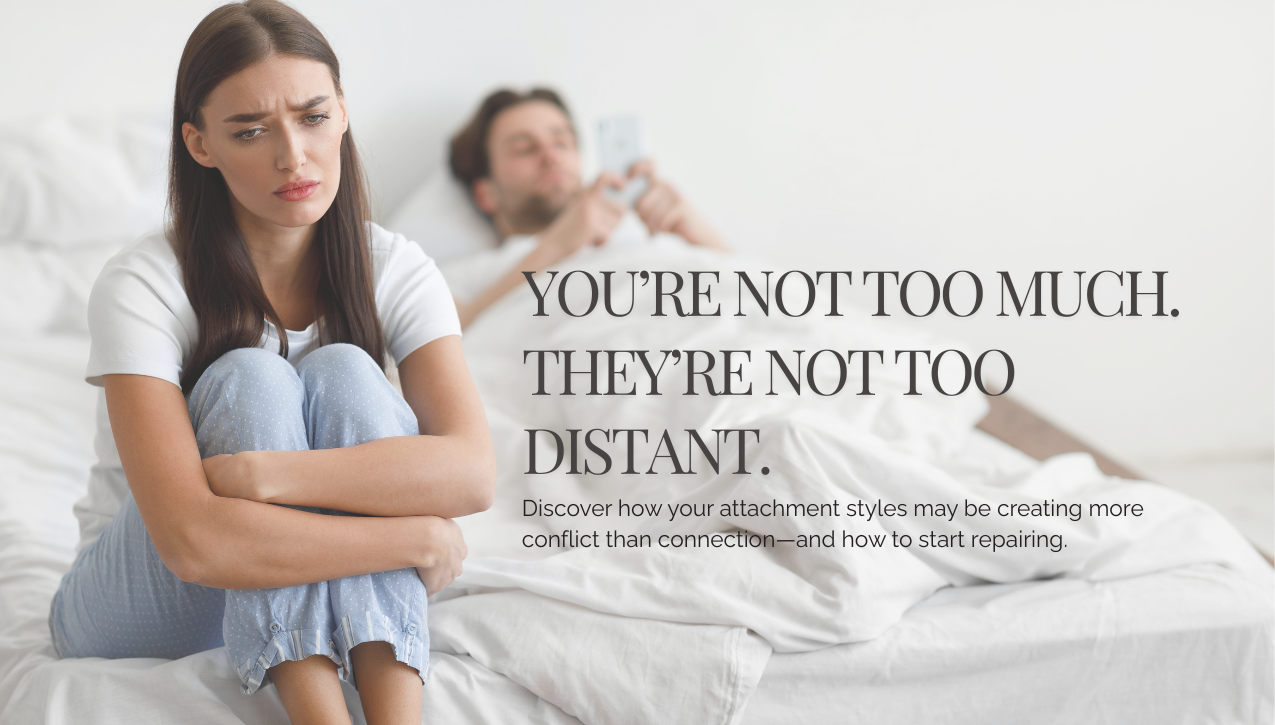You’re Not Too Needy—and They’re Not Too Distant: You Just Have an Attachment Mismatch
Quick Summary
If you feel like you're always chasing emotional connection while your partner pulls away—or vice versa—you’re not alone. You may be experiencing an attachment style mismatch. At Lisa Chen & Associates, we support couples in Hermosa Beach, Los Angeles, and St. Augustine who feel stuck in recurring emotional patterns. Understanding your attachment pairing can help you make sense of these moments—and build a path back to connection.
Take our quiz to find out your attachment dynamic as a couple:
👉 What Happens When Your Attachment Styles Collide? Take the Quiz
You’re Not Too Needy—and They’re Not Too Distant
Maybe you’ve been told you’re “too sensitive,” “clingy,” or “emotionally intense.” Or maybe you’ve felt like your partner is always “too cold,” “unavailable,” or “shuts down” when things get hard.
It’s easy to internalize these labels—especially in close relationships. But the truth is, most of these traits stem from attachment patterns, not personal flaws.
And often, when a couple is stuck in a frustrating loop, it’s not because one person is too much or not enough. It’s because their nervous systems are wired differently when it comes to closeness and emotional safety.
What Is Attachment Style—and Why It Matters
Attachment style refers to the way we connect with others in close relationships—especially during emotional stress, conflict, or vulnerability. It’s like a relational GPS: it tells us whether it’s safe to get close, how much space we need, and what to do when we feel disconnected. Discover your attachment style with this free quiz.
Attachment styles aren’t random—they’re formed early in life, usually based on how our caregivers responded to our needs. If we were met with warmth and consistency, we may grow up feeling secure in love. But if we experienced emotional distance, chaos, or inconsistency, we might develop protective patterns—like shutting down or clinging harder.
Understanding your attachment style—and your partner’s—is one of the most powerful ways to decode your relationship patterns and make real, lasting change.
The 4 Main Attachment Styles
1. Secure Attachment
Feels comfortable with closeness, expresses needs, and trusts others will respond.
2. Anxious Attachment
Fears abandonment, often needs extra reassurance, and may feel “too much” when emotionally activated.
3. Avoidant Attachment
Values independence, may shut down under emotional stress, and often feels overwhelmed by intense closeness.
4. Disorganized Attachment
Wants connection but fears it. This style is often rooted in trauma or unpredictable caregiving, leading to emotional chaos and confusion in relationships.
Most couples don’t have the same style—and that’s where things can get tricky.
What Is an Attachment Mismatch?
An attachment mismatch happens when two people with different attachment styles activate each other’s fears without meaning to. The most common mismatch is the anxious–avoidant dynamic: one partner reaches for connection while the other instinctively pulls away.
Here’s how it might look:
One of you wants to talk it out. The other needs space.
One of you feels panicked when things go unspoken. The other feels cornered by emotional intensity.
You both feel misunderstood. Neither of you feels safe.
The result? A loop that feels like rejection, shutdown, or emotional whiplash—even when both of you care deeply.
This Isn’t Just a Communication Issue
Couples often try to fix these problems with better communication skills. But if your attachment systems are out of sync, no amount of scripts or “I” statements will fix the root pattern.
This isn’t about who’s right or wrong. It’s about how your nervous systems are trying to protect you—in completely different ways.
Avoidant partners tend to protect themselves with distance. Anxious partners protect themselves by getting closer. These strategies are not flaws—they're adaptations. And when unexamined, they create the exact opposite of what each partner needs.
How to Repair the Cycle
The first step is awareness.
Take our quiz to discover your attachment pairing and receive therapist-backed insights tailored to your dynamic.
Then, begin the real work:
Learn how to self-regulate and co-regulate with your partner
Practice emotional pacing—knowing when to lean in and when to pause
Unblend your attachment triggers from the present moment
Work with a therapist who understands attachment theory and nervous system regulation
Change doesn’t happen overnight—but when couples start speaking each other’s attachment language, real intimacy becomes possible.
Here’s how to repair after conflict, according to Gottman research
Take the Quiz Together
You don’t have to keep getting stuck in the same argument. You don’t have to wonder if you’re too much—or if they’ll ever open up.
There’s a reason you feel the way you do. And there’s a way forward.
Take our quiz together to learn what happens when your attachment styles collide—so you can start repairing from the inside out.
👉 Take the Attachment Style Combo Quiz
FAQs
1. Can two people with different attachment styles make it work?
Absolutely. The key is mutual understanding and the willingness to grow. Attachment styles can soften and shift with enough emotional safety and awareness.
2. What’s the most common attachment mismatch in couples?
Anxious–avoidant is the most common and most triggering dynamic. But any mismatch can create disconnection if the cycle goes unexamined.
3. How can therapy help with attachment style issues?
Therapy helps partners understand their own and each other’s styles, work with underlying nervous system responses, and build emotional safety through secure-functioning strategies.


